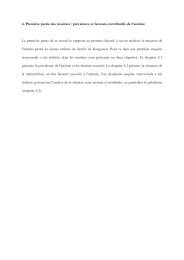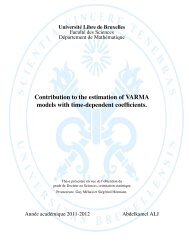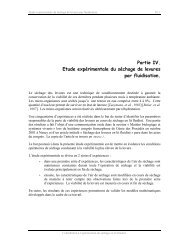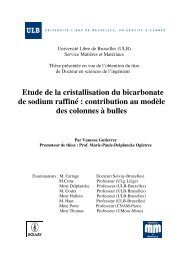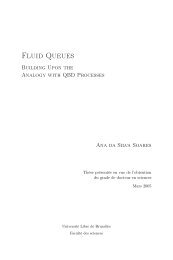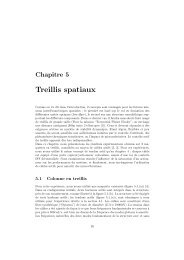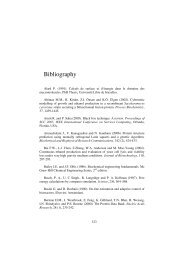Diapositive 1 - de l'Université libre de Bruxelles
Diapositive 1 - de l'Université libre de Bruxelles
Diapositive 1 - de l'Université libre de Bruxelles
Create successful ePaper yourself
Turn your PDF publications into a flip-book with our unique Google optimized e-Paper software.
Chapitre II29 mm in ambital diameter were allocated to each aquarium such as size frequencydistributions were i<strong>de</strong>ntical for all aquaria (Figure 16). Significant mortality occurred in 2aquaria (13 °C and 20.5 °C, 39 psu both; 7 <strong>de</strong>ath individuals on an initial total of 14 and17, respectively).Figure 16: Mean ambital diameter (±S.D.) of the sea urchins at thebeginning (♦) and the end (■) of theexperiment for the different aquaria.Non growing individuals werediscar<strong>de</strong>d from final distribution.Numbers indicate the final effective inthe different aquaria.At the end of the experiment, the sea urchins were dissected and the body wall separatedfrom the inner organs. The skeleton was cleaned of associated tissues with NaOH (proanalysis, Merck) 2 M in Teflon beakers at 50 °C, then rinsed 3 times with Milli Q water.They were dried at 50 °C for 48 hours. Newly formed interambulacral coronal plates(calcein unlabelled) were separated from the ol<strong>de</strong>r ones (calcein labelled) un<strong>de</strong>r anepifluorescence microscope (Figure 17). Nine specimens among a total of 88 survivinganimals at the end of the experiment did not produce new skeleton. They were not furthertaken into account. New plates were weighted. Individual growth rate was calculate as theratio of the weight of newly formed interambulacral plates (mg) on growth duration (d).We consi<strong>de</strong>red this growth rate as the most representative measurement of growth duringthe experiment (in comparison to the increment of mean ambital diameter for eachaquarium, whose initial term is affected by sea urchin mortality and which give no accessto individual data).Field specimens. Ten adult P. lividus were collected in spring 2007 in Marseille (meanannual SST of 17.65 °C according to MEDAR/MEDATLAS regional datasets, MEDARGroup 2002) and immediately dissected. Their tests were cleaned as <strong>de</strong>scribed above anddisarticulated. Whole interambulacral columns were ground in an agathe mortar andstored at room temperature.51



